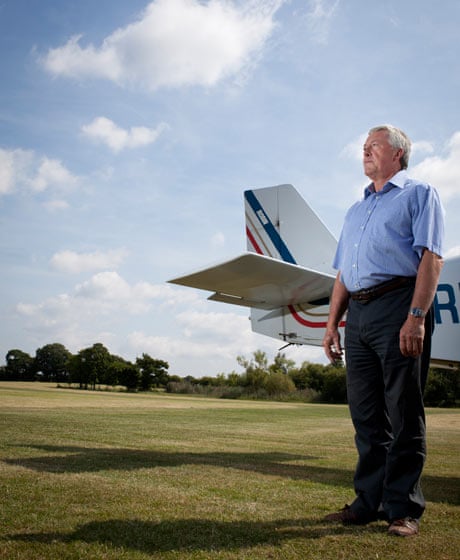In 1962, aged 15, I joined the air force as an apprentice mechanic. I had my first solo air experience the following year, and the thrill of flying never left me. During my decade in the RAF, I'd go up as often as I could – there's a sense of freedom you can't get from anything else.
When I left for a career in engineering, the success of my company meant I was able to build up a collection of historic aircraft, all of which I flew. The one I treasured most was my American P-51D Mustang, Big Beautiful Doll – a silver, single-seater second world war fighter. I took her to air shows all over the world.
The Mustang had always been part of my pension plan, and recently I was given an offer I couldn't refuse. I was delighted when the new owner insisted I continue piloting Big Beautiful Doll. Sadly, our appearance at the Duxford Flying Legends show in July was to be our last.
I was leading a formation with another Mustang and a Skyraider – a solid bomber, half as big again as the Mustang. We'd already performed an identical display and everything had been fine – each element is precisely programmed. But the next day the Skyraider's pilot made a tighter turn than intended, lost sight of me and the tip of his wing caught my undercarriage. There was a terrific bang and I was thrown forward as the plane pitched downwards.
I was shocked I'd been hit by another member of my formation – it never happens. I tried to straighten the plane and head towards open farmland, hoping I could "belly land" it, but it was going down fast. Ideally, you shouldn't use a parachute below 1,000ft, but at around 500ft I realised I wouldn't be able to save the plane and I had to concentrate on saving myself. I made it out at around 250ft. I was conscious not to tug the release ring on the way out – I could have become snagged on the plane and towed with it into the ground. Instead, I pushed myself out of the cockpit, colliding with the tail. As I bounced over it and cleared the plane, I pulled the cord. I felt no fear as I fell – during these crucial seconds, my training kicked in, and every part of me was concentrated on my survival.
There was a space of no more than three or four seconds between the parachute opening and the plane crashing into the wheat field below. A couple of seconds later I, too, hit the ground, fast and hard, landing the way I'd been taught in the RAF four decades earlier. The impact was far less painful than I expected. My right arm – the one that had struck the Mustang's tail – was temporarily paralysed. I was covered in dirt, and every pocket in my flying suit had wheat in it. There was a deep gouge in my flying helmet – evidently, my head had bounced off the tail as well. About 25 yards away, the twisted wreckage of the plane smoked under a settling cloud of dust.
My mobile phone started ringing. It had survived, despite being in a pocket on the sleeve of my flying suit. When I answered, I heard one of my ground crew yelp, "Christ, you're alive!" and the sound of him running through the pilot's enclosure to find my youngest daughter and her husband. When I spoke to her, my daughter's relief was palpable – from her vantage point, she'd been unable to see the parachute, and most people in the enclosure assumed I'd gone down with the Mustang.
The Skyraider pilot had landed safely, I learned, despite losing a chunk of wing. Paramedics checked me over, but apart from the dead arm and bruising, there was nothing wrong with me. I took the next day off work, but just to complete paperwork.
Although she was part of the family for 15 years, I feel philosophical about losing Big Beautiful Doll. The Skyraider pilot freely admits he made a mistake, and I can't feel any ill will over a slight error of judgment. In good condition, a Mustang is worth well over £1m – the crash left an expensive hole in the ground. The son of the owner was at the show and phoned his dad with the news. He was instructed to give me a big hug.
People have asked if I'll ever fly again. In fact, I travelled home the same day in another of my planes, piloted by my daughter, and as we rose over the Cambridgeshire countryside I could hardly have felt more relaxed. I suspect all pilots feel immortal – we'd never leave the ground, otherwise.
As told to Chris Broughton
